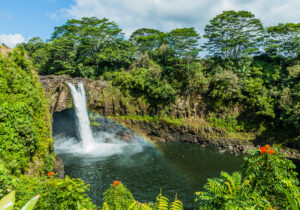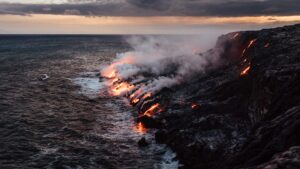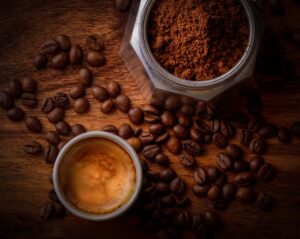Kona is famous for its’ coffee and our Big Island Circle Tour stops at Premium Kona Coffee Farm where you can sip coffee and explore the farm.
Pilot Guides offers some good history on the Kona Coffee Belt and the Kona coffee bean.
Hawaiʻi is only the state in America where coffee is grown and harvested, and it’s an excellent (yet expensive) coffee indeed. The Kona coffee belt (also known as Kona Heritage Corridor) spreads 25 miles along the slope of Mount Hualalai on the Big Island of Hawaiʻi on an altitude between 800-2500 feet. Kona coffee is the market name for the coffee Arabica cultivated on the slopes of Hualalai and Mauna in the north and south districts. It is known to be one of the most expensive coffees in the world, grown on a relatively small territory of approximately 20,000km2. The excellent climate and mineral-rich volcanic soil in the area create formidable and favourable coffee growing conditions.
The coffee along the Kona coast is fully dependent on natural rainfall, so after the winter, early spring brings forth the delicate and beautiful white coffee blossoms. Several rounds of coffee blooming can occur over the next 3-4 months. A fully blooming orchard is known locally as the “Kona snow”. Coffee farms involve practices such as soil monitoring, testing and fertilizing, weed control and pruning to help the coffee bloom become smooth, round, red coffee cherries by early fall. The cherry is the sweet and pulpy fruit of the coffee tree. This fruit begins as a green berry and eventually becomes yellow, crimson, orange, and then finally deep red when it is known as a cherry (which it resembles) and is ready to be picked. Each cherry contains two seeds, which are the gourmet Hawai‘i coffee beans.
Harvesting in Kona begins in early fall and lasts for several rounds until late winter. Loyal workers who have been coming to Greenwell Farms for years to harvest handpick Greenwell Kona coffee. Each tree is hand picked several times between August and January and provides around 15 pounds of cherry – resulting in 2 pounds roasted coffee. Harvesting days are long and require many hours of concentrated work, as well as a sharp eye to distinguish the beans that have reached optimal maturity from those that should be left on the tree to ripen further.
Kona coffee is pulped on the same day to ensure top quality. On a pulp mill, the coffee cherry is forced through specially designed rollers that separate the coffee beans from the red pulpy outer material. The resulting product – a ‘wet parchment’ – is soaked in water for 14 hours or longer, to initiate the fermentation process, which breaks down a layer of mucilage around the outside of the wet parchment. Then it gets rinsed, sun-dried or dried in modern gas fired dryers. On a ‘hoshidana’ (drying platform), the beans are spread out evenly over the drying area and turned over periodically. The dried parchment is then bagged and stored. For each 100 lbs. of coffee cheerry, 23.5 lbs. of parchment is produced on an average.
Dried parchment is allowed to condition by storing it in climate-controlled areas. Once this conditioning has occurred, parchment coffee is then milled, sized and graded. The milling process removes the outer layer of parchment skin and, to some extent, polishes the beans. These coffee beans are then sized into various standard bean sizes. Finally, a large tilted vibrating table is used to grade or separate high quality beans. At the end of this grading table, this new green coffee is then bagged and stamped with appropriate green coffee grade. The Hawaiʻi State Department of Agriculture samples and tests the coffee to confirm grade standards as outlined in the Hawaiʻi State Administrative Rules. For each 100 lbs. of dried parchment delivered to the dry mill, 80 lbs. of green bean is produced.
Roasting is the final stage of coffee production and the key to a good cup of Kona coffee. Roasting coffee is both a science and an art, or so coffee experts say. It requires skill, quality equipment, and a commitment to consistent and reliable results. Coffee roasters are generally rotating drums that tumble coffee beans at a specific temperature and time. Master roasters will watch the appearance, smell and the even the sound made by the beans. The amount of roasting applied to coffee will affect the final flavour, colour, and aroma of the coffee, even the amount of caffeine contained. For each 100 lbs. of green coffee delivered to the roasting facility, 80 lbs of roasted coffee is produced. Greenwell Farms produces three roasts: medium roast, which is the lightest; full city roast, the classic Kona coffee roast and the most popular; and a dark roast with a robust, sweet and smooth taste.
Kona coffee is graded and labelled slightly different to other coffees. Back in the 1980s, the label Kona Coffee was applied to any coffee from anywhere, though the ‘real’ Kona coffee was more expensive to produce than elsewhere. Coffee farmers and the State of Hawai successfully lobbied to make the Kona Coffee label exclusive to the region. The Hawaiʻi Agricultural Society created an inspection and five grades of coffee that is applied before it’s sold as Kona Coffee: Kona Extra Fancy, Kona Fancy, Kona Number 1, Kona Select and Kona Prime. Kona coffee is graded upon the size of the bean, shape (bigger is better), shape, moisture content (=more flavour), and number of defects it contains; the latter being a rather unusual phenomenon in the coffee world. So “Extra-Fancy” contains the largest, most moisture-heavy, and blemish free coffee beans.
The history of coffee and the history of the Big Island, as well as Hawaiʻi’s invasion of planters in the 19th century is deeply intertwined. Coffee was first brought to Kona district back in 1828 by Reverend Samuel Ruggles from Brazilian cuttings, but it was the English merchant Henry Nicholas Greenwell, founder of Greenwell Farms, who established the Kona coffee brand in the 19th century. The 1899 world coffee market crash forced owners to lease their land to their workers, mainly Japanese, Filipinos but also mainland Americans, who had been working prior on sugar cane plantations before the coffee boom took over.
Henry Nicholas Greenwell was born in England in 1826. He graduated from Sandhurst and spent time in Ireland as an officer in the British Army. He sold his military commission after fulfilling his one-year obligation to the Royal Crown when he was 23 years old and left for Australia to make a new start, purchasing a sheep station to go into the wool business. However prices and a drought didn’t keep him there long. Using the capital from this business he went on to form a partnership with a ship captain in 1849 in order travel to San Francisco with a shipload of tools and supplies that could be sold to miners during the Gold Rush.
Upon arrival to San Francisco Bay, the crew deserted and left Henry and his partner to unload their merchandise. Henry hurt himself badly in the process. His partner advised him to go to Honolulu where the best doctors were located in the Pacific as they served Hawaiʻian royalty. Upon his recovery, he returned to San Francisco and found himself out of luck once again: his partner had vanished from the face of the earth with the profits. Henry returned to Honolulu where he was employed on Fort Street with an English import/export company and was sent to Kona to open a store. He arrived in the early 1850s, where luck was about to change for this adventurer and entrepreneur. Following his land reform in 1848, King Kamehameha III had begun selling land to foreigners in 1851. Greenwell purchased a parcel and began farming oranges on 90 acres of land for resale to the whaling ships to prevent scurvy. When the orange crop suffered blight 15 years later, Greenwell left for a trip around the world, stopping in the West Indies in Montserrat where he met a British lime plantation’s daughter, Elizabeth Caroline, whom he married in 1868. Greenwell and his wife went on to raise 10 children and made their home at Kalukalu in Kealakekua.
Henry turned to the coffee business and for several years he bought and marketed the coffee grown in Kona by Hawaiʻians. He gradually acquired extensive land holdings also engaging in the cattle and sheep business. For many years until his death in 1891, Henry Nicholas Greenwell devoted himself to the improvement of the Kona District. He served as postmaster, storeowner, paymaster for school teachers and tax collector of the port of Kealakekua. Henry Greenwell is also remembered for launching Kona coffee into the European market in the 1870’s. In 1873, while participating at the World’s Fair in Vienna he was awarded a ‘Recognition Diploma’ for his Kona Coffee by the President of the Kaiser’s Exposition.
The family tradition continues today, over 150 years later, with fourth-generation farmers Tom and Jennifer Greenwell, who maintain the tradition of high quality Kona coffee at Greenwell Farms. Greenwell Farms is a working Kona coffee farming and processing company. Tom Greenwell, who took the reins of the farm in 1992 after his father’s passing, credits a friend and fellow coffee farmer, Mr. Takashiba, for guiding him through the process of Kona Coffee and establishing a functioning farm with over 30 employees. Greenwell Farms has been instrumental in making custom milling, and Tom Greenwell, a skilled and certified mechanic, has helped develop and create mechanical coffee harvesters.
The Kona Coast celebrates its coffee heritage every year during the Coffee Festival in November. This year marks the 45th anniversary, and involves various celebrations and competitions such as the coffee cupping competition where every single estate farm and larger farm coffee house evaluates the coffee with a blind tasting – sniff, slurp and taste test included. Farmers from across the Kona coffee belt enter their best for an internationally recognized panel of cupping judges to scrutinize the harvest. The Kona coffee farm with perfect “Kona characteristics” will be declared the winner in each of two divisions.




